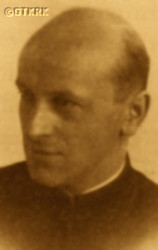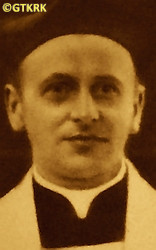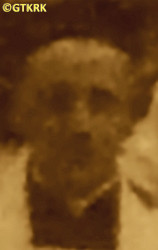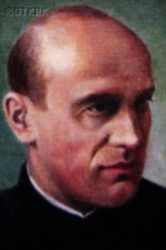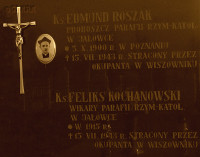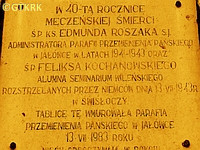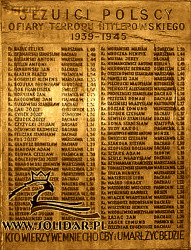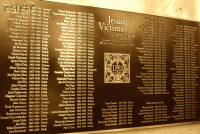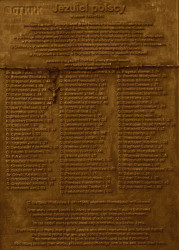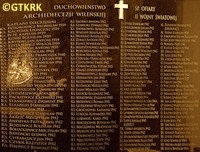Roman Catholic
St Sigismund parish
05-507 Słomczyn
85 Wiślana Str.
Konstancin deanery
Warsaw archdiocese, Poland
full list:
displayClick to display full list

searchClick to search full list by categories
wyświetlKliknij by wyświetlić pełną listę po polsku

szukajKliknij by przeszukać listę wg kategorii po polsku

Martyrology of the clergy — Poland
XX century (1914 – 1989)
personal data
religious status
Servant of God
surname
ROSZAK
forename(s)
Edmund
function
religious cleric
creed
Latin (Roman Catholic) Church RCmore on
en.wikipedia.org
[access: 2014.09.21]
congregation
Society of Jesus SImore on
en.wikipedia.org
[access: 2014.09.21]
(i.e. Jesuits)
diocese / province
Greater Poland‐Mazovian province SI
Polish Province SI (1918‐1926)
academic distinctions
Bachelor of Sacred Theology
date and place
of death
15.07.1943

Svislachtoday: Svislach dist., Grodno reg., Belarus
more on
en.wikipedia.org
[access: 2021.09.29]
alt. dates and places
of death
13.07.1943
details of death
During the Polish–Russian war 1919‐1921 prob. served in the Volunteer Army under the command of the Inspector General, General Joseph Haller, formed on 07.07.1920.
After German and Russian invasion of Poland in 09.1939 and start of the World War II, after start of Russian occupation arrested for the first time by the Russians on 21.09.1939 in Pinsk.
Three days later released.
Moved to Vilnius then under Lithuanian occupation (Russian occupation started there in 06.1940) and there was sent to Jałówka n. Svislach parish.
After German attack on 22.06.1941 of their erstwhile ally, Russians, and start of German occupation warned on 13.07.1943 of impeding arrest, but remained with his parishioners.
Next day arrested by the Germans.
Taken to Svislach prison and from there to the execution site in a small Wishovnik forest, c. 2 km form centre of Svislach where, in a mass slaughter, was murdered ostensibly as a „hostage” by the Germans — part of German extermination plan of Polish intelligentsia of Białystok region, called «Black July» 1943.
cause of death
mass murder
perpetrators
Germans
sites and events
Wiszownik forestClick to display the description, «Black July» 1943Click to display the description, Collective responsibility („Hostages”)Click to display the description, Ribbentrop‐MolotovClick to display the description, Pius XI's encyclicalsClick to display the description, Polish‐Russian war of 1919‐1921Click to display the description
date and place
of birth
05.10.1900Birth certification on:
photos.szukajwarchiwach.gov.pl
[access: 2025.08.19]

Poznańtoday: Poznań city pov., Greater Poland voiv., Poland
more on
en.wikipedia.org
[access: 2021.07.18]
parents
ROSZAK John
🞲 ?, ? — 🕆 ?, ?

MATUSZEWSKA Julianna
🞲 ?, ? — 🕆 ?, ?
presbyter (holy orders)
ordination
23.04.1935

Lublintoday: Lublin city pov., Lublin voiv., Poland
more on
en.wikipedia.org
[access: 2021.08.20]
positions held
c. 1941 – 1943
professor — Jałówkatoday: Michałowo gm., Białystok pov., Podlaskie voiv., Poland
more on
en.wikipedia.org
[access: 2022.11.09] ⋄ Transfiguration of the Lord RC parish ⋄ Białystoktoday: Białystok city pov., Podlaskie voiv., Poland
more on
en.wikipedia.org
[access: 2020.12.11] RC deanery
c. 1940
friar — Vilniustoday: Vilnius city dist., Vilnius Cou., Lithuania
more on
en.wikipedia.org
[access: 2022.01.06] ⋄ St Casimir the Prince and Confessor monastery, Jesuits SI
1937 – 1939
professor — Pinsktoday: Pinsk city dist., Brest reg., Belarus
more on
en.wikipedia.org
[access: 2022.07.16] ⋄ dogmatic theology, St Thomas Aquinas' Theological Seminary
1937 – 1939
professor — Pinsktoday: Pinsk city dist., Brest reg., Belarus
more on
en.wikipedia.org
[access: 2022.07.16] ⋄ St Stanislav the Bishop and Martyr college, St Stanislav the Bishop and Martyr monastery, Jesuits SI — German and French languages' teacher
c. 1936 – c. 1937
Third Probation — (France territory)today: France
more on
en.wikipedia.org
[access: 2023.04.10] ⋄ Jesuits SI
c. 1931 – c. 1935
student — Lublintoday: Lublin city pov., Lublin voiv., Poland
more on
en.wikipedia.org
[access: 2021.08.20] ⋄ theology, Theological Department („Bobolanum” college), Jesuits SI
c. 1930 – c. 1931
friar — Vilniustoday: Vilnius city dist., Vilnius Cou., Lithuania
more on
en.wikipedia.org
[access: 2022.01.06] ⋄ St Casimir the Prince Gymnasium, St Casimir the Prince and Confessor monastery, Jesuits SI — German and French languages' teacher
1926 – 1930
student — Vilniustoday: Vilnius city dist., Vilnius Cou., Lithuania
more on
en.wikipedia.org
[access: 2022.01.06] ⋄ Germanic and Roman Philology, Stephen Batory University [i.e. Vilnius University (from 1945) / some faculties acting clandestinely (1939‐1945) / closed by Lithuanians (1939) / Stephen Batory University (1919‐1939)]
1923 – 1926
student — Nowy Sącztoday: Nowy Sącz pov., Lesser Poland voiv., Poland
more on
en.wikipedia.org
[access: 2021.04.01] ⋄ philosophy, Holy Spirit College, Jesuits SI
1921 – 1923
novitiate — Stara Wieśtoday: Brzozów gm., Brzozów pov., Subcarpathia voiv., Poland
more on
en.wikipedia.org
[access: 2021.12.18] ⋄ Assumption of the Blessed Virgin Mary monastery, Jesuits SI
18.04.1921
accession — Stara Wieśtoday: Brzozów gm., Brzozów pov., Subcarpathia voiv., Poland
more on
en.wikipedia.org
[access: 2021.12.18] ⋄ Assumption of the Blessed Virgin Mary monastery, Jesuits SI
1919 – c. 1920
student — Poznańtoday: Poznań city pov., Greater Poland voiv., Poland
more on
en.wikipedia.org
[access: 2021.07.18] ⋄ natural sciences, Department of Philosophy, Poznań University [i.e. Adam Mickiewicz University (from 1955) / Poznań University (1945‐1955, 1920‐1939) / Piast University (1919‐1920) / Polish University (1918‐1919) / Royal Academy (1903‐1918)]
others related
in death
BESZTA–BOROWSKIClick to display biography Anthony, BURAKClick to display biography Mark, KLIMCZAKClick to display biography Michael Eugene (Fr Dennis), KOCHANOWSKIClick to display biography Felix, KOZŁOWSKIClick to display biography Joseph, KUŹMICKIClick to display biography Witold, OLSZEWSKIClick to display biography Louis, OPIATOWSKIClick to display biography Henry, PĘZAClick to display biography Alexander, PŁOŃSKIClick to display biography Joseph, RUTKOWSKIClick to display biography Bronislav, SKOKOWSKIClick to display biography Justin, SZULCClick to display biography Joseph, SZYPIŁŁOClick to display biography Casimir
sites and events
descriptions
Wiszownik forest: In the Wiszownik forest c. 2 km from Svislach on 15.07.1943 (or 13.07.1943 according to some sources) Germans murdered, as part of their extermination program against partisans, approx. 55 Poles, mainly from Wołkowysk county, jailed as „captive hostages”. Among the victims were 4 local priests. Earlier, in 11.1942, the Germans murdered c. 1,536 Jews from the Svislach area in the same place. (more on: www.flickr.comClick to attempt to display webpage
[access: 2013.10.05])
«Black July» 1943: On 20.05.1943 East Prussia German Germ. Gauleiter (Eng. regional leader), Erich Koch, nominated Otton Helwig a new German commander of SS und Polizeiführer (Eng. SS and police commander) of Bezirk (Eng. region) Białystok. He immediately initiated a pacification action ostensibly targeted at Polish partisans. The real aim was intimidation of the Poles from Białystok region and extermination of its leading classes. Herbert Zimmermann, security police and SD commanded, deputy commander of Einsatzgruppen SS (Eng. Operational Groups) for Germ. Bezirk (district) Bialystok, issued an order to arrest and execute 19 people, physicians, barristers, city staff and teacher, including their families, in each all county cities of the district. On 10.07.1943 a „Commando Müller” (from the surname of its murderous commander, prob. Hermann Müller), consisting of Belarus support batallion, Lithuanian units dressed in German uniforms, German Gendarmerie and police and German Gestapo members, perpetrated a series of mass murders in various places in Bezirk Białystok (including its Łomża and Grodno regions). In 07.1943 Germans murdered more than 1,000 people (prob. near 2,000). On 15.07.1943 only in all county seats of Bezirk Bialystok at least 9 local Polish intelligentsia families, including women, children and old were selected and murdered. Among the victims were many priests: in executions in Pilice forest, Wiszownik forest, Kosówka forest, Navumavichy, Jeziorka, etc. Germans murdered at least 15 clerics. (more on: www.swzygmunt.knc.plClick to attempt to display webpage
[access: 2019.10.13])
Collective responsibility („Hostages”): A criminal practice implemented by the Germans in the occupied territories of Poland, applied from the very first day of World War II. At its core was an appointment and public announcement of a list of names of selected people whose lives depended on absolute compliance with German orders. Any violation of these ordinances, by any person, regardless of the circumstances, resulted in the murder of the designated „hostages”. In the first days of the war and occupation, it was used i.a. by the German Wehrmacht army to prevent acts of continuation of the defense by the Poles. Later, especially in the German‐run General Governorate, it was part of the official policy of the occupation authorities — collective responsibility for any acts of resistance to the occupier's practices. For the life of one German, even if death was due to customary reasons, the Germans carried out executions from a dozen to even a hundred Poles previously designated as „hostages”.
Ribbentrop‐Molotov: Genocidal Russian‐German alliance pact between Russian leader Joseph Stalin and German leader Adolf Hitler signed on 23.08.1939 in Moscow by respective foreign ministers, Mr. Vyacheslav Molotov for Russia and Joachim von Ribbentrop for Germany. The pact sanctioned and was the direct cause of joint Russian and German invasion of Poland and the outbreak of the World War II in 09.1939. In a political sense, the pact was an attempt to restore the status quo ante before 1914, with one exception, namely the „commercial” exchange of the so‐called „Kingdom of Poland”, which in 1914 was part of the Russian Empire, fore Eastern Galicia (today's western Ukraine), in 1914 belonging to the Austro‐Hungarian Empire. Galicia, including Lviv, was to be taken over by the Russians, the „Kingdom of Poland” — under the name of the General Governorate — Germany. The resultant „war was one of the greatest calamities and dramas of humanity in history, for two atheistic and anti‐Christian ideologies — national and international socialism — rejected God and His fifth Decalogue commandment: Thou shall not kill!” (Abp Stanislav Gądecki, 01.09.2019). The decisions taken — backed up by the betrayal of the formal allies of Poland, France and Germany, which on 12.09.1939, at a joint conference in Abbeville, decided not to provide aid to attacked Poland and not to take military action against Germany (a clear breach of treaty obligations with Poland) — were on 28.09.1939 slightly altered and made more precise when a treaty on „German‐Russian boundaries and friendship” was agreed by the same murderous signatories. One of its findings was establishment of spheres of influence in Central and Eastern Europe and in consequence IV partition of Poland. In one of its secret annexes agreed, that: „the Signatories will not tolerate on its respective territories any Polish propaganda that affects the territory of the other Side. On their respective territories they will suppress all such propaganda and inform each other of the measures taken to accomplish it”. The agreements resulted in a series of meeting between two genocidal organization representing both sides — German Gestapo and Russian NKVD when coordination of efforts to exterminate Polish intelligentsia and Polish leading classes (in Germany called «Intelligenzaktion», in Russia took the form of Katyń massacres) where discussed. Resulted in deaths of hundreds of thousands of Polish intelligentsia, including thousands of priests presented here, and tens of millions of ordinary people,. The results of this Russian‐German pact lasted till 1989 and are still in evidence even today. (more on: en.wikipedia.orgClick to attempt to display webpage
[access: 2015.09.30])
Pius XI's encyclicals: Facing the creation of two totalitarian systems in Europe, which seemed to compete with each other, though there were more similarities than contradictions between them, Pope Pius XI issued in 03.1937 (within 5 days) two encyclicals. In the „Mit brennender Sorge” (Eng. „With Burning Concern”) published on 14.03.1938, condemned the national socialism prevailing in Germany. The Pope wrote: „Whoever, following the old Germanic‐pre‐Christian beliefs, puts various impersonal fate in the place of a personal God, denies the wisdom of God and Providence […], whoever exalts earthly values: race or nation, or state, or state system, representatives of state power or other fundamental values of human society, […] and makes them the highest standard of all values, including religious ones, and idolizes them, this one […] is far from true faith in God and from a worldview corresponding to such faith”. On 19.03.1937, published „Divini Redemptoris” (Eng. „Divine Redeemer”), in which criticized Russian communism, dialectical materialism and the class struggle theory. The Pope wrote: „Communism deprives man of freedom, and therefore the spiritual basis of all life norms. It deprives the human person of all his dignity and any moral support with which he could resist the onslaught of blind passions […] This is the new gospel that Bolshevik and godless communism preaches as a message of salvation and redemption of humanity”… Pius XI demanded that the established human law be subjected to the natural law of God , recommended the implementation of the ideal of a Christian state and society, and called on Catholics to resist. Two years later, National Socialist Germany and Communist Russia came together and started World War II. (more on: www.vatican.vaClick to attempt to display webpage
[access: 2023.05.28], www.vatican.vaClick to attempt to display webpage
[access: 2023.05.28])
Polish‐Russian war of 1919‐1921: War for independence of Poland and its borders. Poland regained independence in 1918 but had to fight for its borders with former imperial powers, in particular Russia. Russia planned to incite Bolshevik‐like revolutions in the Western Europe and thus invaded Poland. Russian invaders were defeated in 08.1920 in a battle called Warsaw battle („Vistula river miracle”, one of the 10 most important battles in history, according to some historians). Thanks to this victory Poland recaptured part of the lands lost during partitions of Poland in XVIII century, and Europe was saved from the genocidal Communism. (more on: en.wikipedia.orgClick to attempt to display webpage
[access: 2014.12.20])
sources
personal:
www.bialystok.opoka.org.plClick to attempt to display webpage
[access: 2013.01.06], pl.wikipedia.orgClick to attempt to display webpage
[access: 2012.11.23], photos.szukajwarchiwach.gov.plClick to attempt to display webpage
[access: 2025.08.19], www.hagiographycircle.comClick to attempt to display webpage
[access: 2012.11.23], archive.todayClick to attempt to display webpage
[access: 2021.12.19]
bibliographical:
„Vilnius archdiocese clergy martyrology 1939‐1945”, Fr Thaddeus Krahel, Białystok, 2017
„Jesuits on Polish and Lithuanian territory knowledge encyclopedia, 1564‐1995”, Fr Louis Grzebień SI (editor), WAM Printing House, Cracow 1996
original images:
wzchbialystok.plClick to attempt to display webpage
[access: 2022.11.09], wzchbialystok.plClick to attempt to display webpage
[access: 2022.11.09], ksiegahonoru.salon24.plClick to attempt to display webpage
[access: 2017.11.07], www.flickr.comClick to attempt to display webpage
[access: 2014.09.21], wzchbialystok.plClick to attempt to display webpage
[access: 2022.11.09], www.sowiniec.com.plClick to attempt to display webpage
[access: 2016.03.14], college.holycross.eduClick to attempt to display webpage
[access: 2013.05.19], www.miejscapamiecinarodowej.plClick to attempt to display webpage
[access: 2014.05.09], www.ciekawepodlasie.plClick to attempt to display webpage
[access: 2020.07.31]
LETTER to CUSTODIAN/ADMINISTRATOR
If you have an Email client on your communicator/computer — such as Mozilla Thunderbird, Windows Mail or Microsoft Outlook, described at WikipediaPatrz:
en.wikipedia.org, among others — try the link below, please:
LETTER to CUSTODIAN/ADMINISTRATORClick and try to call your own Email client
If however you do not run such a client or the above link is not active please send an email to the Custodian/Administrator using your account — in your customary email/correspondence engine — at the following address:

giving the following as the subject:
MARTYROLOGY: ROSZAK Edmund
To return to the biography press below:
 Click to return to biography
Click to return to biography








